If you want to get started playing blues rhythm guitar, one of the best ways to begin is by learning some basic blues chords.
The blues is not a structurally complex genre. Most blues songs are based around a simple 12 bar chord progression. And this progression is typically constructed using just three fairly simple chords.
Of course this is not always the case. There are a whole range of blues musicians who deviate from the standard 12 bar blues form and use complex chords in their rhythm playing.
The great news however, is that if you want to make a start playing blues rhythm guitar, you can go a long way by just learning a handful of basic blues chords.
And that is what I will be looking at in this article. I will be covering the following:
In the interest of full disclosure, this article goes quite a way beyond basic chord diagrams.
For whilst it is fun to learn new chords, in my opinion it is more important – and ultimately more rewarding – to develop a deeper understanding of why you are playing these chords, how you can use them in context, and how you can build on them to play more complex chords in the future.
Of course, if you just want to learn the basic blues chords listed here and nothing more, you can do that as well. Having said that though, whilst some of the theory might at first be difficult to understand, it will do a lot to improve your guitar playing and musicianship. So do try and stick with it, and I promise that it will be worth it!
Without further ado then, here are the basic blues chords you need to know to get started playing blues rhythm guitar:
What are basic blues chords?
Before we dive into the specifics, I think it is important to first define exactly what I mean by ‘basic blues chords’.
Hopefully the ‘basic’ part of this definition is fairly straightforward. If you have played guitar chords prior to reading this article, then you will have no doubt encountered chords of varying complexity. Some chords form easy patterns on your fretboard.
They don’t require much dexterity or strength from your fretting hand. And it is easy to move into and out of these chord shapes.
Conversely, others present much more of a challenge. They demand more strength from your fretting hand, involve big stretches, and are difficult to form quickly.
In this article, I will be looking at chords that fit the former description. For the most part the chords outlined here don’t pose too much of a problem for your fretting hand. As such, you will be able to learn and play them fairly quickly and easily.
When it comes to defining ‘blues chords’, things become a little more difficult. This is because to accurately define blues chords you need to understand what makes them different to ‘regular’ chords. And here it is important to understand a little chord theory.
As such, if you are interested in learning the theory, I would recommend reading the following articles before you continue here:
Each of these articles will help to give you a deeper understanding of how chords are formed. This will make the next section of this article much easier to understand.
And whilst you don’t need to know this information to get started using basic blues chords in your playing, it will help you to understand what you are playing. In turn this will make you both a better guitar player and musician.

Basic blues chord construction
Blues chords are formed when specific intervals are stacked on top of each other.
As you might expect, there are a whole range of different chords used in blues music. Yet there are certain types of chords which blues musicians use much more frequently. And of these, dominant 7th chords are the most common.
A dominant 7th chord is one that contains both major and minor intervals. Specifically, it contains all of the same notes and intervals as a pure major chord, but it also features the addition of a flat or minor 7th (more on this below). The chord formula of a dominant 7th chord is as follows:
1 3 5 b7
This mixing of the minor and major intervals creates a slightly tense and unresolved sound in the chord. It is a sound that we now associate with the blues, because in many ways, dominant 7th chords have come to define the sound of the genre.
They have been used almost since the inception of the blues, and they feature in many of the most famous blues songs of all time.
If you want to get started playing blues rhythm guitar then, learning all of the basic dominant 7th chords is the best place to start.
And the great news here is that the shapes of these dominant 7th chords are very similar to those of the major chords with which you might be familiar.
Let’s look at this in a bit more detail:
Open position dominant 7th chords
There are dominant 7th versions of all of the chords with which you might be familiar. There is an A7 chord, an E7 chord, and an G7 chord etc. And these chords appear all over the neck of your guitar.
Here though we are going to look at dominant 7th chords in what is called the ‘open position’ on your guitar. If you have not heard this term before – it simply refers to the position on your guitar where you construct chords using open strings.
Many of the ‘regular’ major chords with which you may be familiar – like A, E and G – amongst others – make use of open strings.
It is a good idea to learn these open position chords when you first get started with rhythm playing. Not only do they have a full and resonant sound, but they are easier to play than barre chords, which require more strength and dexterity from your fingers.
The dominant 7th chords I have outlined below also make use of your open strings. Not only this, but they are similar in construction to the open position major chords with which you might be familiar.
This is because they contain the same 3 notes that appear in a pure major chord. The only difference is that they also contain an additional note (the flat 7th or minor 7th).
As such, I will be talking about these new blues chords in relation to the open position major chords with which you might be familiar. This will help you to learn these blues chords more quickly. The changes in the fingerings are minimal and so you don’t need to learn a whole number of new and different chord shapes.
Here are the open position dominant 7th chords that will help you to get started on blues rhythm guitar:

All of these chords are written out with a ‘7’ directly after the letter. And this is the way in which they appear in sheet music and songs. It is worth remembering this, because there are other types of ‘7’ chords also used in the blues. And so appreciating the methods used to notate a dominant 7th chord will save you some confusion later on!
As you can see from the diagram above, in the case of many of these blues chords there is just one note (or finger) which separates them from regular major chords. This is true, even though the blues chords contain more intervals than their major chord counterparts.
This is because they make use of the open strings on your guitar. When you remove one of your fingers from an open position chord, the open string adds a new note to the chord. So learning these basic blues chords in the open position allows you to play more harmonically complex chords without having to learn demanding chord fingerings.
Using basic blues chords in context
If you are totally new to the world of blues chords and rhythm guitar, I would recommend pausing at this point. Take some time to commit the chords listed above to memory. Get comfortable with their shapes, and memorise them by name.
Once you have done that, just have fun experimenting with them. Play the chords with different strumming patterns, and practice moving between them in different ways. This will help you to consolidate the shapes of the chords, and also develop your rhythm guitar skills.
Once you have done that, the next step is to apply these chords in a more realistic playing context. Specifically, I would recommend using them to play the 12 bar blues.
If you already know what the 12 bar blues is and how to play it, then you’re all set! You can take the chords listed above and use them to play the 12 bar blues. However, if you don’t know what the 12 bar blues is, or if you don’t feel totally comfortable playing it, then don’t worry.
Here I will run through the 12 bar blues progression in depth, and cover the essential theory you need to understand what the 12 bar blues progression is and how you can play it.
The 12 bar blues
The 12 bar blues is the most commonly occurring chord progression in the blues. Blues musicians have used it since the beginning of the 20th century, and it features in many of the most famous blues songs of all time.
In technical terms, the 12 bar blues is a chord progression that lasts for 12 bars, or measures. These 12 bars are then typically repeated throughout the course of the song.
The 12 bar blues progression is normally made up of 3 chords. Specifically it is based around the I, IV and V chords of any given key.
To understand what the I, IV and V chords are and how they relate to the chords listed above, we again need to delve into a little theory:
Keys, scales & chord structures
Western music is based around ‘keys’. These keys refer to the note and scale that a piece of music is centred around. If for example, someone says ‘this song is in the key of C major’, they mean that the song is based around the notes of the C major scale.
As noted in more detail in this article here, there are 7 notes in the major scale. And each of these notes has a corresponding number. So C is 1, D is 2 and so on.
Chords within a key are marked out in a similar same way. The notable difference is that chords are denoted by Roman numerals. So in the key of C major, the note of C is marked as 1, and the chord of C is marked as I. This remains the same, regardless of the key in which you are playing.
In the key of A major for example, A is the 1st note, and the chord of A is referred to as the I chord. There are still 7 notes in the key of A, but the note that the key starts on (also referred to as the root or tonic note) is different. The specific notes which appear in the key are also different.
The I, IV & V chords
A typical 12 bar blues progression is based around the I, IV and V chords in any given key. Let’s look at this in practice. In the key of C major, the notes of the scale are as follows:
| C | D | E | F | G | A | B |
C is the first note of the scale and is marked as 1. F is the 4th note in the scale and G is the 5th. Now as I covered in much more detail in this article here, if you harmonise the notes of the C major scale to create chords, you end up with the following pattern of chords:
| Note name | C | D | E | F | G | A | B |
| Type of triad | Major | Minor | Minor | Major | Major | Minor | Diminished |
As mentioned above, chords within a key follow the same pattern. The only difference is that they are marked with Roman numerals, rather than numbers. From here then, we can see that in the key of C – the I, IV and V chords are as follows:
| C | F | G |
| I | IV | V |
You can apply this idea to any key. All you need to do is count up from the tonic note of the key. So if someone tells you that a song is in the key of A, you just need to map out the notes of the A major scale, and then pick out the I, IV and V chords from there. In the A major scale, the notes are as follows:
| A | B | C# | D | E | F# | G# |
Looking at the key of A then, we can see that the I, IV and V chords are as follows:
| A | D | E |
| I | IV | V |
Understanding this concept will do a lot to improve your skills as a blues guitarist. You will quickly be able to play blues songs in a range of keys. And if you have ambitions of joining in at a local blues jam, then understanding this will help you to do so with confidence.
The 12 bar blues in practice
Understanding the theory of the major scale, and appreciating how the notes of the scale correspond to the chords used in a 12 bar blues progression is a significant first step.
It is important to note however that in practice, the pure major chords listed above are always turned into dominant 7th chords in a blues context. Pure major chords sound happy and upbeat, and as such, they lack some of the tension that is important in the blues.
To understand the theory behind switching all of the major chords listed above into dominant 7th chords is beyond the scope of the article. It is also unlikely to be particularly relevant or useful for you at this moment.
Instead, the key pieces of information you need to understand at this stage are as follows:
- Pure major chords are not often used within the 12 bar blues
- The pure major chords given in the examples above are replaced with their dominant 7th equivalents (which I have included on the chord diagram above)
In the key of C then, you would play the 12 bar blues using the chords of C7, F7 and G7. Similarly, in the key of A, you would play a 12 bar blues progression using the chords of A7, D7 and E7.
Below I have included the keys in which I would recommend you play at this stage. I have added in the chords which appear in each of these scales, along with chord diagrams for each key. In this way you will be able to refer to these diagrams and play the 12 bar blues in a variety of different keys.
The pattern of the 12 bar blues
Now you know the basic structure of the 12 bar blues and how to apply it to different keys, the next step is to learn how the I, IV and V chords fit together within the progression. And luckily, this is nice and easy.
The 12 bar blues is easiest to understand if you break it down into 3 sections – each one 4 bars long.
The first 4 bars run as follows:
| I | I | I | I |
In the second 4 bars, the IV chord is introduced, and the 4 bars run like this:
| IV | IV | I | I |
In the final section of the progression – the V chord is introduced:
| V | IV | I | V |
This final section of the 12 bar blues is also called the ‘turnaround‘. This is because the progression finishes during these 4 bars before it loops back to the beginning and starts again.
Written out in this way, it is quite difficult to appreciate how the progression looks in its entirety. This changes however, when we piece all of the different sections together:
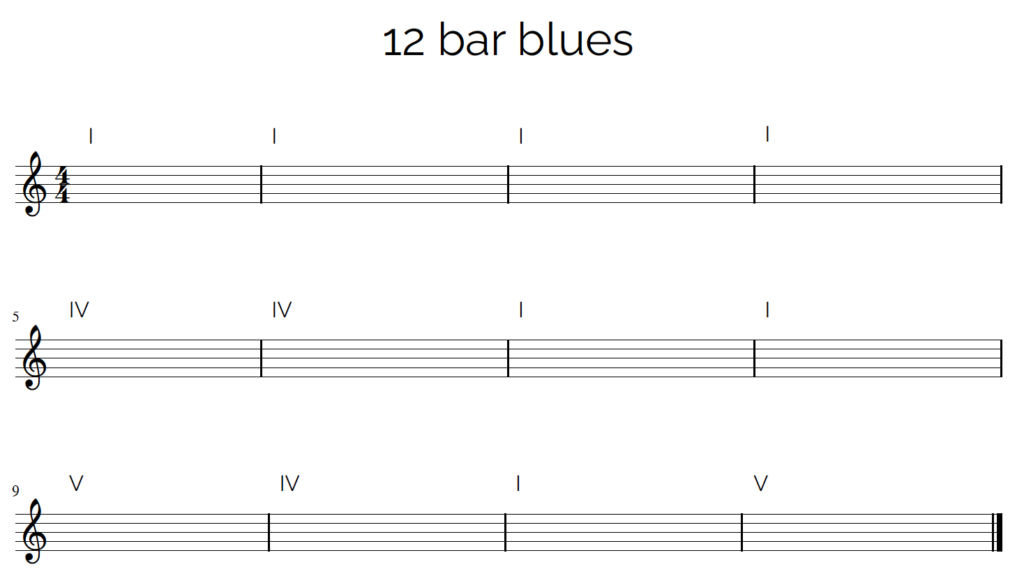
This shows you how the progression is structured. The next step from here is to apply a specific musical key to the structure. Sticking with our example of C, the 12 bar blues in the key of C is as follows:
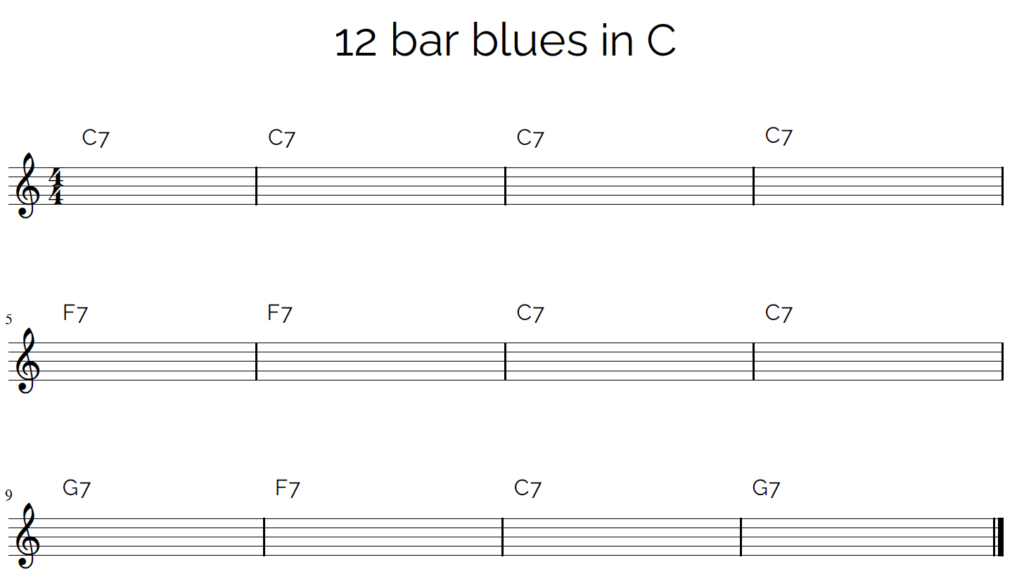
When this 12 bar blues progression is ‘tabbed’ out using the kind of shuffle rhythm that often appears in the blues, this is what it looks like:

And at 120 beats per minute (BPM), this is what the above progression sounds like:
At this stage, don’t worry too much about the rhythm and strumming patterns used in the example above. The most important thing here is to get comfortable with the different blues chords outlined above, and to start using them in a practical context.
Having said that, if you do want to learn more about some of the different rhythms used in the blues I would recommend reading the following articles on the topic:
Either way, once you have played through the 12 bar blues in the key of C using the basic blues chords outlined above, you can experiment with the same progression in a variety of different keys. So you can play the 12 bar blues in the key of D, E and A etc.
Changing keys
To help with this, In the table below I have outlined the keys that I would recommend experimenting with at this stage.
I have included the I, IV and V chords which appear in these keys, and I have turned these into dominant 7th chords, because as noted above – these are the chords that you will actually use in a practical context.
| Key | A | C | D | E | G |
| I, IV & V chords | A7 | D7 | E7 | C7 | F7 | G7 | D7 | G7 | A7 | E7 | A7 | B7 | G7 | C7 | D7 |
This is what all of the chords in those keys look like when you present them together:
Key of A
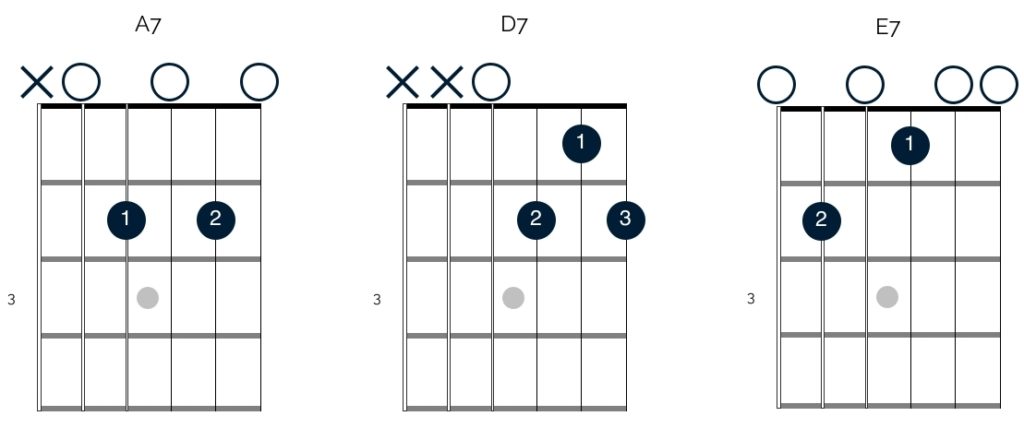
In the key of A then – the I chord is A7, the IV chord is D7 and the V chord is E7.
Key of C
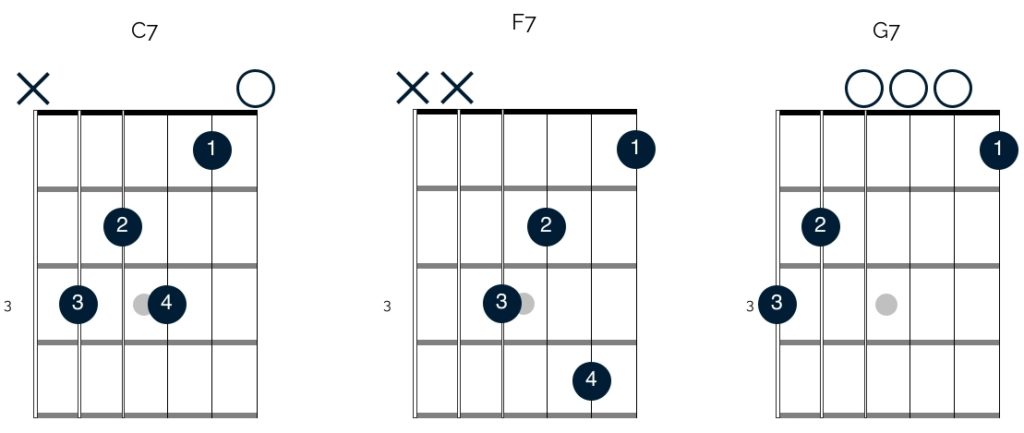
In the key of C then – the I chord is C7, the IV chord is F7 and the V chord is G7.
Key of D
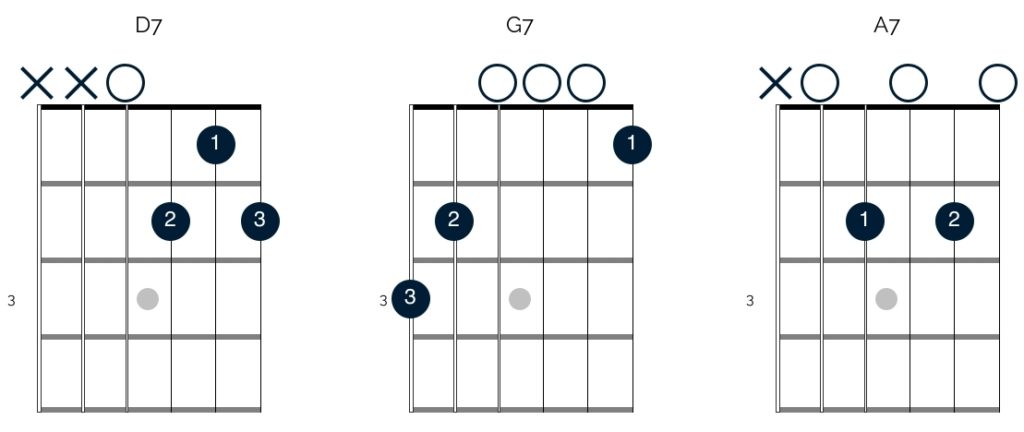
In the key of D then – the I chord is D7, the IV chord is G7 and the V chord is A7.
Key of E
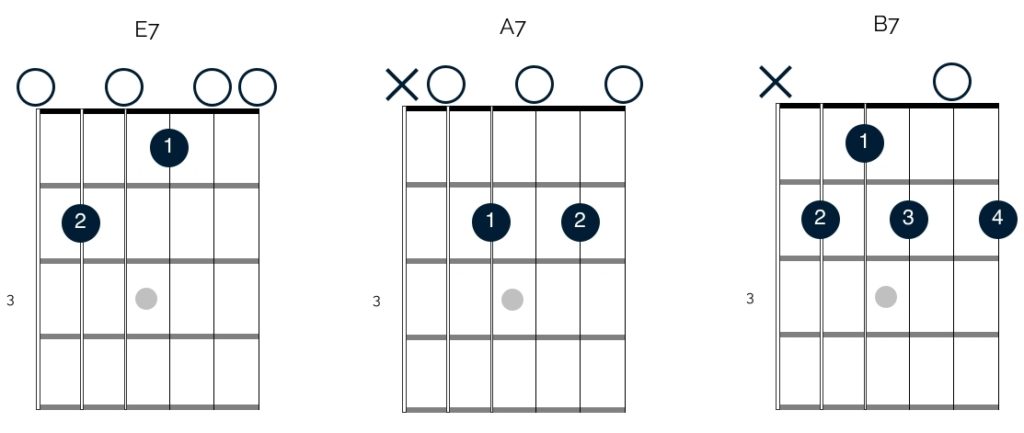
In the key of E then – the I chord is E7, the IV chord is A7 and the V chord is B7.
Key of G
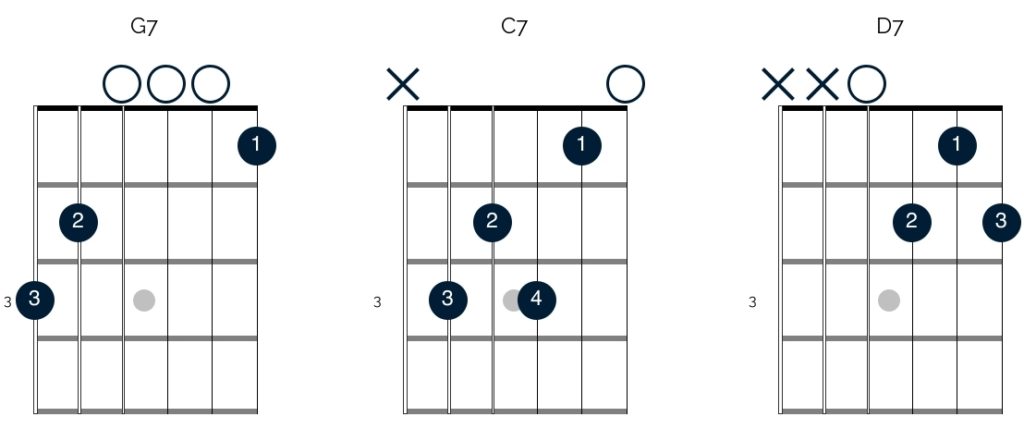
In the key of G then – the I chord is G7, the IV chord is C7 and the V chord is D7.
The reason I recommend these keys is because they only contain the basic blues chords that I have included above.
This is not true of all keys. In a lot of keys, the 4th note of the scale will be sharp (#). And this means that you have to play chords beyond those included in this article.
Take the key of B as an example. The notes of the B major scale are as follows:
| B | C# | D# | E | F# | G# | A# |
As you can see, the 5th note of the scale is sharp. So the same is true of the V chord. In the key of B then, the I, IV and V chords are as follows:
| B | E | F# |
| I | IV | V |
So if you play a 12 bar blues in the key of B, you have to play an F# for the V chord.
I don’t want to get too deep into the theory of what sharps (and also flats) are and why they appear in different keys. For now though it is just important to know that they appear in every key apart from the key of C major and A minor.
Luckily, all of the key signatures that I have added in above are beginner friendly. This is because the 4th and 5th notes of the scale (and therefore the IV and V chords) are not sharp.
As such, I would recommend sticking with these keys and just work on experimenting with all of the different blues chords included above.

Closing thoughts
At this stage, I appreciate that you might be feeling a little overwhelmed. I have gone far beyond simply outlining basic blues chords here. And so if you clicked onto this article looking for chord diagrams and nothing more, your head might be spinning.
I appreciate that some of the theory included here is difficult to understand at first. And truthfully, it is not necessary if you just want to learn the chords included in the diagram above and nothing more.
Yet having said that, having some theory knowledge will go a long way in helping you to develop, both as a guitarist and a musician.
Not only will it give you a greater understanding of what you are playing, it will also help you to create solid foundations, which you can build on to learn more varied and complex blues chords in the future.
Good luck guys! Let me know how you get with learning these chords. And if you have any questions at all, just send me an email on aidan@happybluesman.com. I’m always around and happy to help!
References & Images
Piano Scales, Pixabay, Hello Music Theory, Open Music Theory, Modern Music Theory For Guitarists





Responses
Explained so well. I feel I just leveled up a notch reading this. I subscribe, keep it up!
Thank you so much Tyler, your comment made my day! 😁 I am very glad to hear you’re enjoying the articles, and please do let me know if I can help with your playing in any way. You can always reach me on aidan@happybluesman.com!